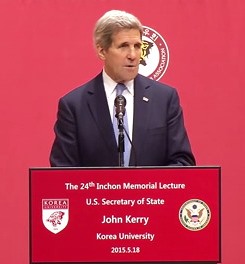The term “offensive cyberspace operations (OCO)” has been added to the official Department of Defense lexicon, and the term is discussed in depth in a newly discovered Department of Defense doctrinal publication by the Joint Chiefs as Staff. How is this term defined and when should the military resort to offensive cyberspace operations? See below for excerpts from the report related to offensive cyberspace operations. Here is a pdf of the full report: Cyberspace Operations Joint Publication 3 12R
According to the report, “offensive cyberspace operations (OCO) are cyberspace operations (CO) intended to project power by the application of force in and through cyberspace.” Like offensive operations in the physical domains, the report states that OCO will be authorized “. . . via an executive order” and “.. . require[] deconfliction in accordance with (IAW) current policies.”
However, these offensive attacks are not boundless in scope. The report specifically limits such directed military attacks to “military targets” which “. . . by their nature, location, purpose, or use . . . are those objects whose total or partial destruction, capture, or neutralization offers a direct and concrete military advantage.”
Cyberspace attacks are defined as those attacks, according to the report, “. . . that create various direct denial effects in cyberspace (i.e., degradation, disruption, or destruction) and manipulation that leads to denial that is hidden or that manifests in the physical domains.” The report then highlights actions used to create denial and manipulation effects, dividing denial effects into three categories: those that degrade, disrupt, or destroy.
The scope and methodology behind “targeting” is explained in detail throughout the report. According to the report, “. . . cyberspace targets should be nominated, vetted, and validated within the established targeting process, [a process which requires] close coordination within DOD, with interagency and multinational partners, and with key allies.” It is especially important that targeting protocol is followed when it comes to cyberspace operations, as the report warns that “. . . uncoordinated actions could expose or interfere with the actions” of the entities.
In addition to discussing offensive cyberspace operations, the report notes some of the continuing threats in cyberspace as well as the challenges the military faces when it comes to cyberspace operations. Listed below are some of the threats and challenges cited in the report:
Threats:
(1) Cheap Alternative to Building Expensive Weapons: “. . . the application of low-cost cyberspace capabilities . . . represent an inexpensive way for a small and/or materially disadvantaged adversary to pose a significant threat to the US.”
(2) Nation State Threat: “Other nations may employ cyberspace to either attack or conduct espionage against the US. . . . [t]his threat is potentially the most dangerous because of access to resources, personnel, and time that may not be available to other actors.”
(3) Transnational Actor Threat: “. . . formal and informal organizations that are not bound by national borders . . . use cyberspace to raise funds, communicate with target audiences and each other, recruit, plan operations, destabilize confidence in governments, and conduct direct terrorist actions within cyberspace.”
(4) Criminal Organization Threat: “. . . steal information for their own use or, in turn, to sell to raise capital . . . may be used as surrogates by nation states or transnational actors to conduct attacks or espionage through CO.”
(5) Individual Actors or Small Group Threat: “. . . gain access into systems to discover vulnerabilities, sometimes sharing the information with the owners;” may be driven by “political motivations” or may be “. . . exploited by criminal organizations or nation states.”
(6) Insider Threats: “. . . one of the most significant threats to the joint force;” “malicious insiders may exploit their access at the behest of foreign governments, terrorist groups, criminal elements, unscrupulous associates, or on their own initiative.” The consequences for DOD and national security can be devastating, “[w]hether malicious insiders are committing espionage, making a political statement, or expressing personal disgruntlement.”
Challenges:
(1) Capabilities Revealed: While cyberspace operations may be executed remotely, one challenge of cyberspace operations is “. . . that the use of a capability may reveal its functionality and compromise future effectiveness.”
(2) Cyberspace Integration/Synchronization: Cyberspace operations will often “. . . require coordination across the interagency” because the “[e]ffects in cyberspace may have the potential to impact intelligence, diplomatic, and law enforcement efforts.”
(3) Private Industry: DOD will be required to work with private industry because “[m]any of DOD’s critical functions and operations rely on commercial assets, including Internet service providers and global supply chains, over which DOD has no direct authority to mitigate risk effectively.”
(4) Routine Uses of Cyberspace: There are many routine uses of cyberspace by the military, including sending emails, using the Internet to complete on-line training courses, etc. However, “. . . it is through these routine uses of cyberspace where a majority of vulnerabilities on our networks are exposed to, and exploited by, our adversaries.” Internet-based capabilities used for both official and unofficial purposes “. . . pose security risks that are not fully understood.”
(5) Interorganizational Considerations: While military leaders must work with the other members of the national security team to promote unified action, “. . . [a] number of factors can complicate the coordination process, including the agencies’ different and sometimes conflicting policies, legal authorities, roles and responsibilities, procedures, and decision-making processes.”
(6) Multinational Considerations: “National agendas for each country of the multinational force may differ significantly from those of the US, creating potential difficulties in determining the CO objectives.”
For a more in-depth discussion of these threats and challenges, as well as proposed solutions, read the full report here.




Leave a Reply